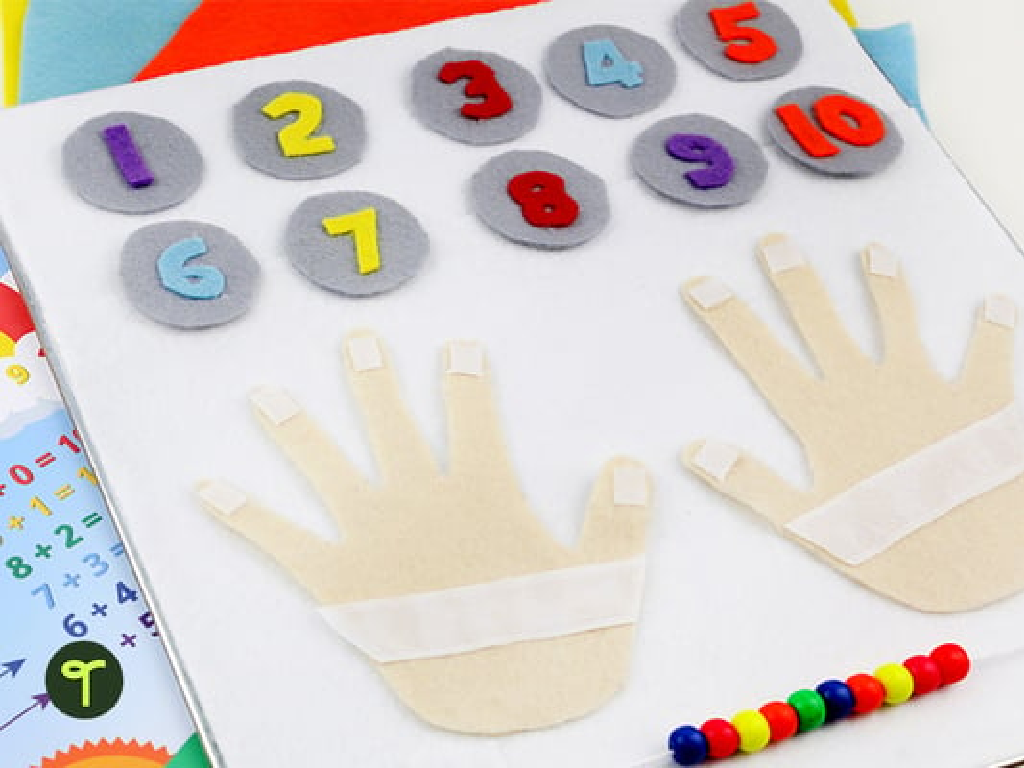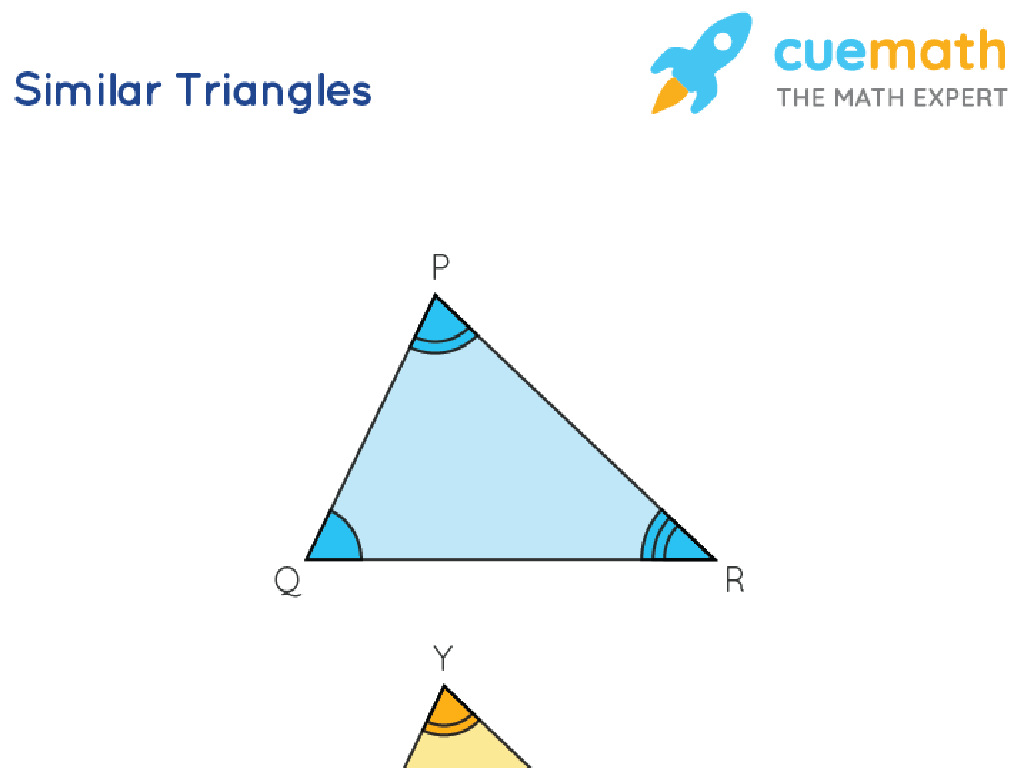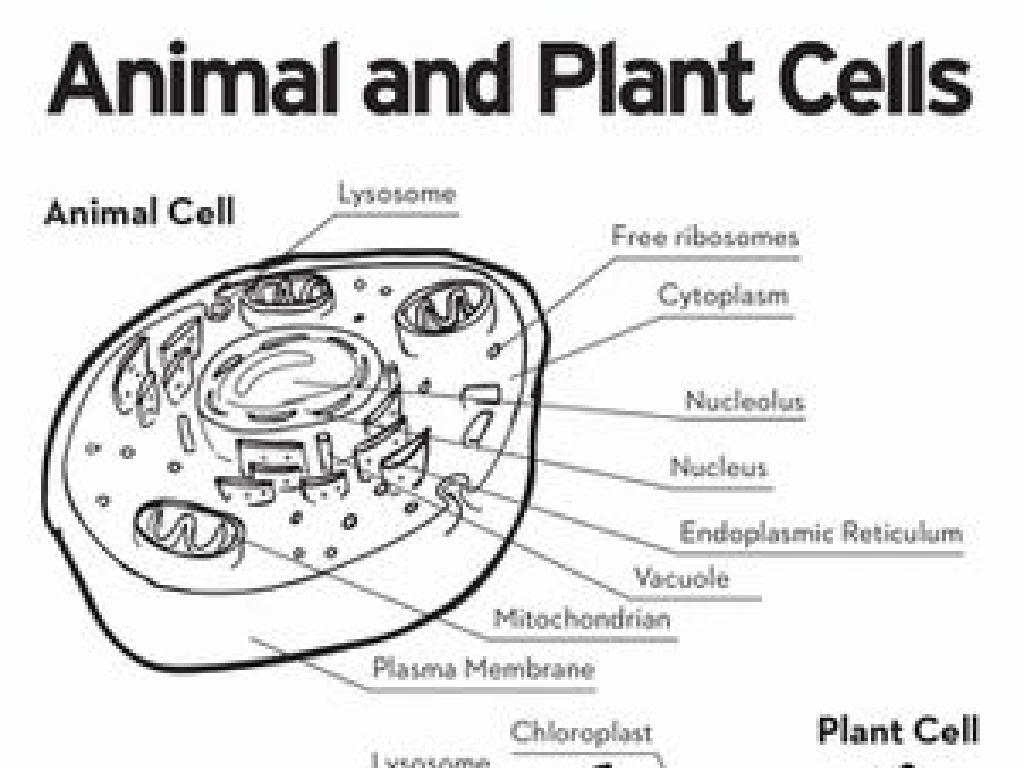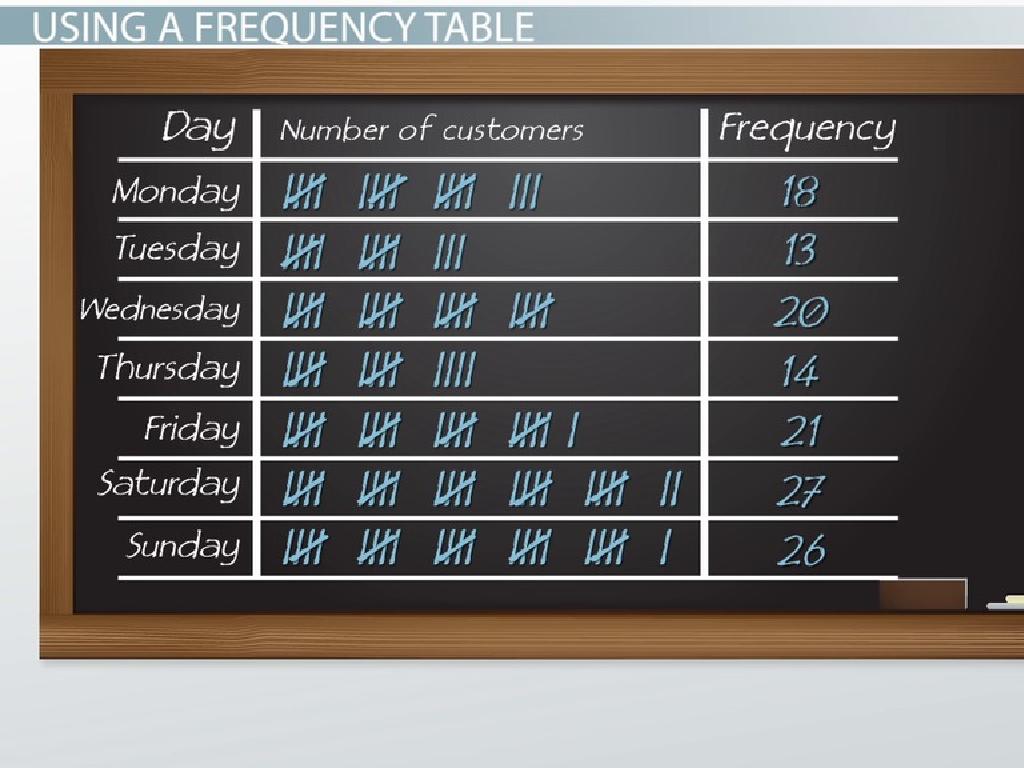Write Tens And Ones - Up To 30
Subject: Math
Grade: Kindergarten
Topic: Numbers And Counting To 30
Please LOG IN to download the presentation. Access is available to registered users only.
View More Content
Welcome to Numbers: Tens and Ones
– Learning about tens and ones
– Numbers are like building blocks
– Just like stacking blocks, we stack ones to make a ten!
– Counting with tens and ones up to 30
– 10 ones make a ‘ten’, and we add more ones up to 30
– Practice makes perfect
– We’ll use fun activities to practice counting!
|
This slide introduces the concept of tens and ones to Kindergarten students, framing it in the context of building blocks to make it more relatable and easier to understand. Emphasize that numbers are built by combining tens and ones, similar to how they might stack blocks to build something. Show them that when they have 10 ones, they can ‘exchange’ these for one ‘ten-block’. Use visual aids like actual blocks or illustrations to demonstrate this concept. Encourage the students to practice counting in tens and ones, using examples and interactive activities. For instance, you can have them group items in sets of ten and then count any additional ones. This hands-on experience will help solidify their understanding of the number system up to 30.
Understanding Tens and Ones
– Numbers have tens and ones
– Tens are bundles of ten
– Imagine 10 sticks tied up together
– Ones are single units
– A single stick on its own
– Visualizing with sticks
– Let’s pretend sticks are our numbers!
|
This slide introduces the foundational concept of place value to Kindergarten students, focusing on tens and ones. Start by explaining that all numbers are made up of tens and ones. Use physical props like bundles of sticks to demonstrate tens and show individual sticks for ones. This visual and tactile approach helps young learners grasp the abstract concept of place value. Encourage the students to group items in tens and ones to practice. For example, use crayons or blocks to make groups of ten and then count any leftovers as ones. This hands-on activity will solidify their understanding of how numbers are structured in a fun and engaging way.
Counting with Tens and Ones
– Ten sticks make ‘one ten’
– Imagine bundling 10 sticks with a rubber band
– Bundle ten ones to form a ten
– When you have 10 single items, group them to make ‘one ten’
– Count ones using fingers
– Use each finger to represent ‘one’ until you reach ten
– Practice making tens with objects
– Find items like blocks or buttons to group into tens
|
This slide introduces the concept of tens and ones, which is fundamental in understanding place value. Start by explaining that a group of ten individual items can be thought of as ‘one ten’. Use physical objects like sticks to demonstrate this concept, bundling them together to form a ten. Encourage the children to use their fingers to count from one to ten, reinforcing the idea that ten ones make a ten. Provide various small objects for the children to practice grouping into tens. This hands-on activity will help solidify their understanding of counting in tens and ones, preparing them for more advanced place value concepts.
Counting Numbers 1 to 10
– Count 1 to 10 using objects
– Use items like blocks or fingers to count
– Each number is one more
– Understand that 2 comes after 1, 3 comes after 2, and so on
– Let’s practice counting together
– Repeat after me as we count each number out loud
|
This slide is aimed at helping Kindergarten students understand the concept of counting from 1 to 10. Start by introducing objects such as blocks or fingers to visually represent each number. Emphasize that each subsequent number represents one more than the previous number. Engage the students by having them count along with you out loud, reinforcing their understanding of the sequence of numbers. Make sure to go at a pace that allows all students to keep up and participate. This activity lays the foundation for understanding the base-ten system, which will be crucial as they progress in their mathematical learning.
Making Tens with Objects
– Grouping ones to make tens
– Like bundling 10 straws together
– 10 ones make ‘one ten’
– A bundle of 10 straws is ‘one ten’
– Practice grouping objects
– Use toys or blocks to group into tens
– Counting tens together
– Let’s see how many tens are in 30
|
This slide introduces the concept of tens and ones, which is fundamental in understanding place value. Start by explaining that when we count objects one by one, we can group them into sets of ten to make counting easier. Use physical objects like straws, blocks, or beads to visually demonstrate the grouping of ten ones to form ‘one ten’. Encourage the children to practice with hands-on activities where they group items into tens and then count how many tens they have made. This will help them visualize the concept of tens and ones and prepare them for understanding larger numbers. The goal is to make the learning process interactive and fun, so they can easily grasp the concept of grouping in tens.
Writing Tens and Ones – Up to 30
– Understanding the tens place
– ‘1’ in the tens place represents one ten
– Counting ones after tens
– Write remaining number in the ones place
– Practice writing numbers
– Let’s write 23 as two tens and three ones
– Examples up to 30
– 10 is one ten and zero ones, 25 is two tens and five ones
|
This slide introduces the concept of place value to Kindergarten students, focusing on tens and ones up to the number 30. Start by explaining that the first digit in a two-digit number tells us how many tens we have. Then, show that the second digit indicates the number of ones left over. Use visual aids like blocks or drawings to represent tens and ones, and practice writing numbers in this format. For example, the number 23 consists of two tens (which is 20) and three ones. Encourage students to use objects like sticks or counters to group into tens and ones for better understanding.
Counting 11 to 20 with Tens and Ones
– Understanding numbers 11 to 20
– Each number has one ten
– Think of it as a group of ten plus extra ones
– Counting the ones in each number
– Let’s count the ones together: 11 (1 ten + 1 one), 12 (1 ten + 2 ones)
– Practice counting with examples
– Example: 14 is 1 ten and 4 ones
|
This slide is aimed at helping Kindergarten students understand the concept of tens and ones for numbers 11 to 20. Start by explaining that all these numbers begin with a ‘1’ which represents one group of ten. Then, focus on the second digit of each number, which represents how many ones are added to the ten. Use visual aids like counting blocks or drawings to show one group of ten and the additional ones. Encourage the students to count out loud and use their fingers if necessary. Provide examples and practice opportunities, such as counting objects grouped into tens and ones. Reinforce the concept by asking students to form numbers using blocks or other manipulatives.
Counting from 21 to 30
– Understanding 21 to 30
– Numbers 21 to 30 have ‘2’ in the tens place.
– Two tens and extra ones
– Each number has 2 tens (20) plus 1 to 10 more ones.
– Writing numbers 21-30
– Let’s write these numbers step by step on paper.
– Practice counting together
– We’ll count aloud as a class from 21 to 30.
|
This slide is aimed at helping Kindergarten students understand the concept of tens and ones within the numbers 21 to 30. Start by explaining that all these numbers begin with a ‘2’, which represents two tens, or twenty. Then, each number adds one more than the previous, showing the ones increasing. Demonstrate writing each number and encourage the students to write along. Finish with a fun counting activity where the whole class counts from 21 to 30 together, reinforcing their understanding of the sequence of numbers.
Let’s Practice Writing Tens and Ones!
– Practice writing numbers
– Use blocks to represent tens and ones
– Each block stack represents a ‘ten’, single blocks are ‘ones’
– Draw tens and ones on paper
– Draw a group of ten and some extra ones to show numbers up to 30
– Complete the worksheet activity
– Fill in the numbers using tens and ones on your worksheet
|
This slide is designed to reinforce the concept of tens and ones through hands-on practice. Provide students with physical blocks to stack in groups of ten, which will help them visualize the concept of ‘tens’. Then, have them draw representations of these groups on paper, adding ‘ones’ as needed to form numbers up to 30. Distribute worksheets with exercises for writing numbers as tens and ones, ensuring that each student understands how to break down a number into tens and ones. This activity will solidify their understanding of place value within the context of numbers up to 30. Encourage students to count aloud as they work with the blocks and drawings to further enhance their learning experience.
Class Activity: Building Numbers with Blocks
– Pair up and use blocks to build numbers
– Create numbers up to 30
– Show and explain your number to the class
– Understand tens and ones
– Each ‘ten’ is a group of 10 blocks, and ‘ones’ are single blocks
|
This activity is designed to help Kindergarten students understand the concept of tens and ones in a hands-on way. By using physical blocks, students can visually and tangibly group them into sets of ten to represent ‘tens’ and use single blocks to represent ‘ones.’ This concrete representation helps them grasp the abstract concept of place value. Teachers should guide the students through the process, ensuring they understand how to group the blocks and articulate their thought process when they present their numbers to the class. Possible variations of the activity could include using different colored blocks for tens and ones, challenging students to build the highest or lowest number possible, or asking them to find multiple ways to represent the same number with blocks.






